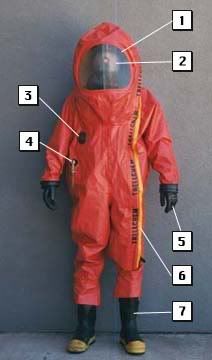Auxiliaries:
Though Council Edict brought all the ship crews into the military hierarchy and standardized ranks an insignia, the individual ships have mostly kept their company uniforms and colors. Most ship crews have either one or two piece uniforms of light to medium monocrys.
For internal security and defense against pirates, virtually all civilian ships carried some type of small arms and body armor for the crew to use.
Ablative Armor Jacket:
An inexpensive civilian body armor of heavy monocrys with armorplas inserts and a cloth covered, medium coating of ablative foam. The jacket provides full protection against crushing and impaling attacks; however, it is heavy and not very flexible, it can’t be concealed under clothing or worn with other armor. The ablative jacket weighs 9 pounds. It is fire resistant and treated for CBW.
General Vacuum Suit:
These are general purpose vacc suits used by the military and commercial operators for repair work outside the ships, rescue work and operations on airless worlds. Each one has a life support pack with two centar air tank and a re-breather that permits duration of 6 centars. The suit is of tough, heavy monocrys backed with flexible plastic polymers. The suit has multiple pockets, tool harness and 20 emergency patches. There is a helmet light, 500 metric two way radio, anti glare visor, radiation alarm and magnetic soled boots.
There are a number of style variations in Vac suits, largely reflecting the age of the suit, its intended function, commercial designs and personal taste.
General Purpose Military/Industrial Vacuum Suit
Emergency Vacuum Suit:
Literally EVERYONE in the Fleet has one of these, even small children, and wears it on their belt. Training in their use begins as soon as a child can begin to dress itself.
The one piece, light plastic suit with built in hood, face mask and re-breather is designed for a single use. They come in a compressed package that is worn in a belt pouch. There is a small attached oxygen cylinder with a ten centon supply of air. The built in re-breather unit allows the cylinder to last for 30 centons. There are four emergencey patches, two placed outside and two inside. There is an external valve that will allow the suit to be connected to a larger air supply.
The suit is very baggy and loose fitting, allowing hands to be withdrawn from the arms to manipulate things inside the suit and, for example, hold an infant. (Most parents carry extra suits for their children in addition to the one carried by their child.) Removing them from the carrying pouch allows them to shaken out and then stepped into. The front seal is closed, the attached air cylinder opened. This can be done in 30 microns.
In every corridor, cabin, closet and store room are located racks of emergency air tanks and/or air valves where tanks can be refilled or a suit can be hooked to directly.
The suits are of tough, tear resistant plastic, but they are not armor and they are not insulated or heated. They are a one use item. Removing them after wearing them, damages the seals to the point that they cannot be resealed.

1: Transparent face shield 2: Re-breather unit 3: Pressure Release Valve 4: Air intake valve 5: Attached gloves 6: One use, front seal 7: Integrated boots
Civilian ‘Touring Suits’ are purchased by civilians, travellers and passengers who use the suits for sight seeing, ‘adventure’ vacations and personal pleasure. There are some significant difference between military/industrial suits and civilian touring suits.
Light Duty Vacuum Suit. (Touring Suit)
These suits are a common civilian style of ‘Touring Suit’. The basic structure employs a light weight monocrys, form fitting fabrics and less reinforcing and insulation. The suit is intended for short trips and its designers were more concerned with the comfort of the wearer then the durability and extended functionality of the suit.